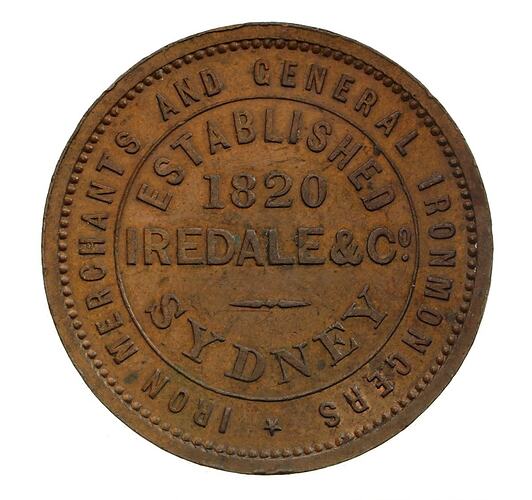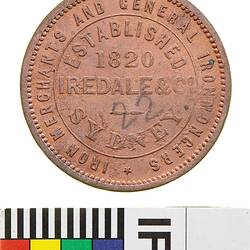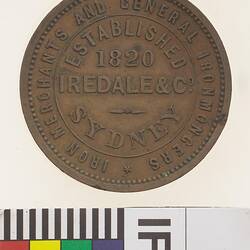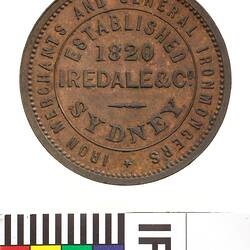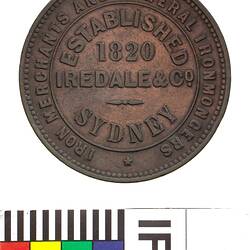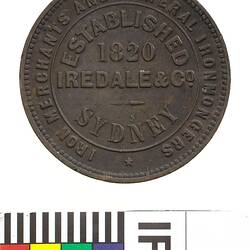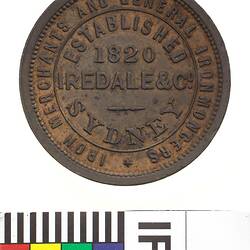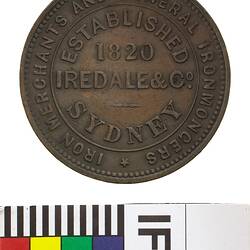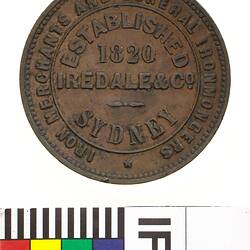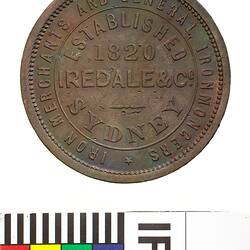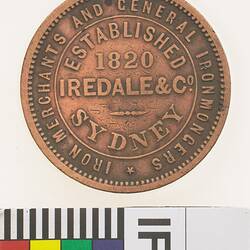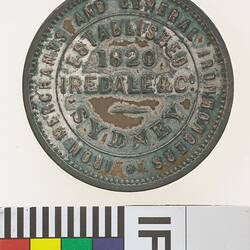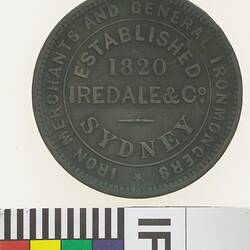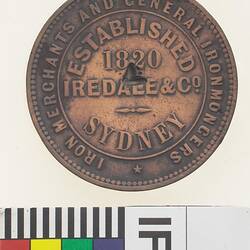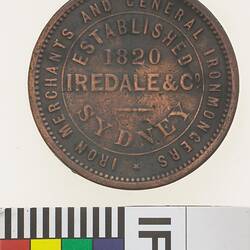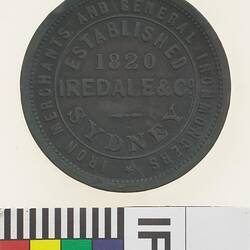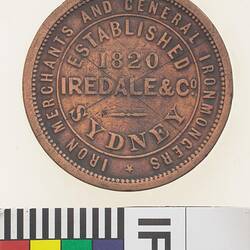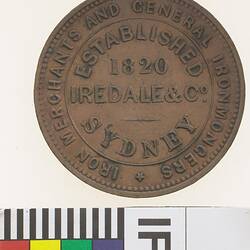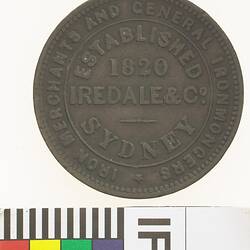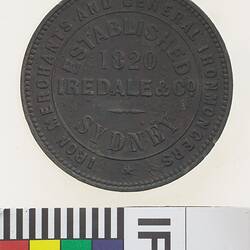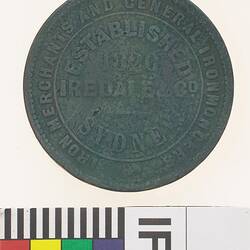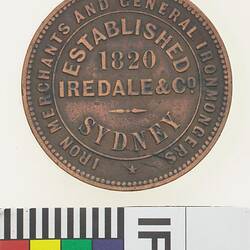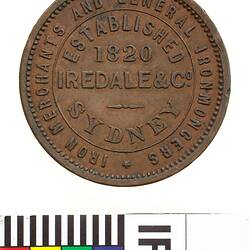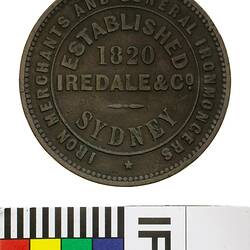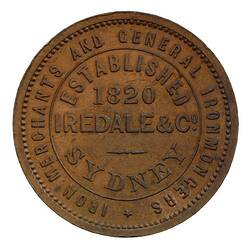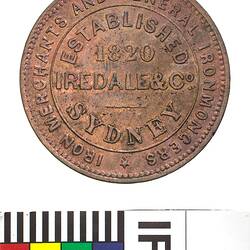Iredale & Co
Lancelot Iredale, an emancipated convict, founded this ironmongery firm in 1820. He had been transported to New South Wales in 1816 at the age of 27. His initial address, 67 George Street South, became 372 George Street in a renumbering in 1844. The founder died in June 1848. A watercolour portrait of Lancelot, painted in 1830, is held by the State Library of New South Wales.
In 1844 Iredale and Co. provided supplies to the expedition mounted by explorer Ludwig Leichhardt, which crossed Australia from Sydney to Port Essington. The following year Lancelot's son Robert took over the business.
Thomas, Robert's brother, and Frederic Lassetter joined the firm in 1850. He was an experienced businessman with an accounting background, he revitalised operations with his live wire approach. In 1852 he married Charlotte Iredale, Lancelot's daughter. In the early 1850s Iredale and Co. issued their first tokens. Their issue was the cause for a complaint by Captain Ward of the newly established Sydney Mint, who felt that the issue of tokens was undesirable and suggested that they be withdrawn from circulation. In 1855 the address changed to 313 George Street, only to become 472 in 1858. George Iredale, another brother, joined the firm in 1855.
Lancelot Jr., the grandson of the founder, was listed as the principal of the firm in 1861 after Thomas' death. In that same year the company took up a large warehouse in York Street. Robert left the firm in 1863 and opened a hardware store at 546 George Street, near where fellow token-issuer J.M. Leigh had had his tobacconist's shop in 1851.
F. Lassetter & Co
The firm was renamed in 1864, becoming F. Lassetter and Co.. The business sold its previous premises and moved to 419-421 George Street West, just north of Market Street. The company retained their new premises until the twentieth century. By 1878 the company had expanded a number of times, and in that year they became a limited liability company. By 1890 F. Lassetter and Co. was one of the largest hardware companies in Australia with warehouses in both York and Clarence Streets. By 1894 the business had grown into a general emporium taking up nearly a whole block, and by the time of Lassetter's death in 1911 it had over 1000 employees and was one of the largest businesses in Sydney. In addition to his vigour in his business, Frederic was active in public life, particularly in Local Government.
His son Henry had been involved in the business since 1891 and took over the business when Frederic died. He was the commander of the NSW mounted rifles during the Boer War. His death in 1926 marked the beginning of the business' decline. The Great Depression brought an end to this century-old business, which was broken up in 1929.
Trade Tokens & Advertising
The company's first token issue dates to 1851, or soon after, which they employed the Birmingham firm Heaton & Sons to strike. This makes Iredale and Co. one of the earliest token-issuing businesses in Australia.
Iredale & Co. advertised in directories and newspapers in regional New South Wales and Queensland during the 1850s and 1860s. The breadth of the range they advertised is an indication of the size and reach of the business at the time. An advertisement in the Wagga Wagga Express of 25 December 1858 promoted their stock of '1000 tons of BBH Crown Iron' in forms such as: 'Sheet Iron 8 to 26 gauge'; 'Blister, spring, shear and cast steel'; and 'Axle blocks, cart boxes, mould boards'. The address given in the advertisement is York Street, Sydney, calling into question the chronology given by May (1988).
In 1861 Iredale & Co. was advertising a range of products in Sydney, through the Sydney Morning Herald. On April 3 they ran four advertisements, one below the other, drawing attention to 'IVORY TABLE CUTLERY', 'AMERICAN HARDWARE', 'MODERATEUR LAMPS', and 'FURNISHING IRONMONGERY.'
The 1864 name change, from Iredale & Co. to Frederick Lassetter & Co., and change of address from York Street back to George Street, is documented in an advertisement published in Pugh's Queensland Almanac for 1864 (see Multimedia Tab and Supplementary File for copies of the advertisement). The text includes the statement that 'FL purchases ENGLISH, CONTINENTAL, and AMERICAN GOODS under peculiar advantages.' The statement is evidence of the changes in the advertiser's vocabulary over the last 140 years, and of the shift in the idiomatic meaning of the word 'peculiar.'
In Bradshaw's Almanac and General Guide for 1864, Lassetter's new premises were given almost three pages of description, covering their architecture, the disposition of stock, and the satisfaction that the new buildings had given their owner. In the current context, a piece like this would be designated an 'advertorial'. The State Library of New South Wales holds a photograph of F. Lassetter & Co.'s premises at 421 George Street, dated 1870, and an architect's sketch showing the expanded premises circa 1898.
In 'Samson's National Directory of New South Wales for 1867-1868', Frederic Lassetter and Co. took out a full page advertisement listing a huge range of stock including, 'Materials for Blacksmiths and Wheelwrights.Materials for Builders.All kinds of tools.Firearms &c..Pumps.(and) Furnishing Ironmongery.' A similar advertisement was included in Bradshaw's Almanac for 1869.
Iredale Token Variations
Iredale was a large issuer of tokens production of which involved four obverse and six different reverse dies. There were six issues with the Justice reverse, on which the word AUSTRALIA seems to have been individually entered. This has resulted in slight differences in the spacing of the first and last letters and the sea horizon, slight differences in the position of the pans of the scales held by Justice and the letters and in the position of the head of Justice in relation to the letters RA of AUSTRALIA. Type One was their first issue and is the only one with the Britannia reverse. Type Two has 9.0 mm between the first A of AUSTRALIA and the sea horizon, 8.6 mm between the last A and the sea. A line drawn across the tops of the scale pans would almost touch the lowest point of the last A of AUSTRALIA and be below the first A. Type Three has 7.5 mm between the first A of AUSTRALIA and the sea horizon, 9.1 mm between the last A and the sea. A line drawn across the tops of the scale pans would pass below the last A of AUSTRALIA and through the middle of the first A. Type Four has 6.5 mm between the first A of AUSTRALIA and the sea horizon, 6.5 mm between the last A and the sea. A line drawn across the tops of the scale pans would pass above the first and last A of AUSTRALIA. Type Five has 8.3 mm between the first A of AUSTRALIA and the sea horizon, 8.3 mm between the last A and the sea. A line drawn across the tops of the scale pans would pass below the first and last A of AUSTRALIA. Type Six has 9.0 mm between the first A of AUSTRALIA and the sea horizon, 9.0 mm between the last A and the sea. A line drawn across the tops of the scale pans would pass below the first and last A of AUSTRALIA.
The obverse of all dies bore the same legend. The die for the type A obverse was characterised by the letters of the word SYDNEY being 2.5 mm tall; 128 dots around the edge; an oval shaped O in Co; and the H of MERCHANTS being placed in the middle of the I of IREDALE. The die for the type B obverse was characterised by the letters of the word SYDNEY being 2.5 mm tall; 113 dots around the edge; an oval shaped O in Co; and the H of MERCHANTS being placed adjacent to the top of the I of IREDALE. The die for the type C obverse was characterised by the letters of the word SYDNEY being 3 mm tall; 116 dots around the edge; an oval shaped O in Co; and the H of MERCHANTS being placed above the top of the I of IREDALE. The die for the type D obverse was characterised by the letters of the word SYDNEY being 3 mm tall; 116 dots around the edge; a circular shaped O in Co; and the H of MERCHANTS being placed adjacent the top of the I of IREDALE.
References:
May, Tom (1988). 'Tokens of George Street,' Australian Numismatist, (Special Bicentennial Edition), pp.21-36.
Advertisement, The Wagga Wagga Express, 25 December 1858, p.1.
Advertisement, Samson's National Directory of New South Wales for 1867-1868, advertisements p.17.
Advertisement, Pugh's Queensland Almanac for 1864, unnumbered page.
Read, R., Painting;"Lancelot Iredale, 1830"Collection of the State Library of New South Wales.
Pickering, C.P., Photograph;"Lassetter & Co., wholesale and retail ironmonger, 421 George Street, Sydney."Collection of the State Library of New South Wales.
Joseland, H., Drawing "Lassetter's George Street frontage in 1898."Collection of the State Library of New South Wales.
Advertisements. Sydney Morning Herald. 3 April 1861: p.2.
Bradshaw's Almamac and General Guide, 1864, pp.xxviii-xxxi.
Advertisement. Bradshaw's Almanac for 1869, unnumbered page (back cover).
More Information
-
Keywords
-
Localities
-
Authors
-
Article types
